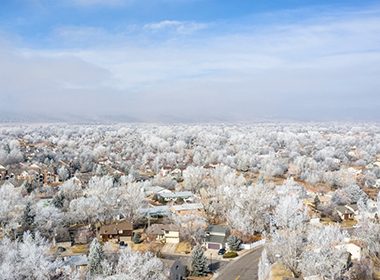
Like everything else – Colorado’s housing market has a supply chain issue
Record setting lows in housing inventory once again push median pricing to new highs, magnifying issues of affordability
ENGLEWOOD, CO – It seems everywhere we turn these days, there is a supply chain issue. No matter the size or scope of the product and services in demand, the supply chain is often the culprit in any effort to meet consumer wants and needs.
Colorado’s housing market is just another example of the dramatic impact that a depleted supply chain has on a market as the inventory of active listings in the Denver-metro area and statewide fell to record lows in November for both single-family and condominium/townhomes, according to the latest monthly market data from the Colorado Association of REALTORS®. The extreme lack of inventory helped push median pricing to all-time highs across the state as buyers continued to deliver above-asking price contracts.
“By most economic accounts, the demand for homes shows little sign of abatement for 2022 and with most transactions closing more quickly than ever before, the housing inventory shortage appears to be as persistent as many other supply chain issues currently playing out across the globe,” said Fort Collins-area REALTOR® Chris Hardy.
7-County Denver Metro Area:
Looking at the seven-county Denver metro area, there were just 2,409 active listings of single-family homes in November, down nearly 40% from October and -49% from where the market sat a year prior. Looking at the condo/townhome market, active listings fell to 908 total listings, off nearly 33% from October and down more than 67% from November 2020. Both are all time lows for the Denver metro area since CAR began tracking these figures in 2010.
The months supply of inventory also fell to all-time lows at 0.5 months in all housing categories, meaning that if no more homes came on the market, the Denver metro area would be completely out of inventory in approximately two weeks. Those numbers reflect a 50% drop in inventory supply from a year prior for single-family homes and a nearly 70% decline in the condo/townhome market.
“Aurora, one of the top 60 largest cities in the United States, currently offers 142 active listings across all price ranges throughout the entire City,” said Aurora-area REALTOR® Sunny Banka.
With continued, albeit slightly lesser volume, buyer demand and above asking price offers pushed median pricing for single-family homes to a near record $580,000 in November, up 17.2% from a year ago, while the condo/townhome market is up more than 16% from November 2020 to a record high $392,000.
“One could accurately say that an identical (Denver County) home is $58,750 more expensive this year than last and twice as difficult to find over 2020 while being three times harder to find than pre-covid times,” said Denver-area REALTOR® Matthew Leprino.
Statewide:
Turning to the statewide data, November delivered less than 6,100 active single-family listings, down 29% from October and off nearly 40% from a year prior. The condo/townhome inventory has been hit hard as well with just 1,654 active listings statewide, down 28% from October and off nearly 62% year over year.
Months supply of inventory also fell to historic lows and is now hovering just above the two-week mark for both single-family and condo/townhomes. Those figures represent a 46% and 68% decline year over year, respectively.
“The fall has felt slower, more like a typical seasonal slowdown,” said Boulder-area REALTOR® Kelly Moye. “But in reality, the inventory is just so low that there are fewer homes to sell.”
In both the Denver metro and statewide analysis, conditions continue to keep issues of housing affordability in the spotlight. CAR’s Housing Affordability Index, a measure of how affordable a region’s housing is to consumers based on interest rates, median sales price and median income by county, remains at historic lows, down approximately 15% from November 2020.
Taking a look at some of the state’s local market conditions, Colorado Association of REALTORS® market trends spokespersons provided the following assessments:
AURORA
“A home for the holidays is the number one requested gift this year. Just as with all the other supply chain shortages, we still have a very large shortage of homes in Aurora and Centennial. Centennial inventory is down 71% from 2020 with just 20 homes currently available in the entire City of Centennial. Plan to pay a median price of $657,000, which is up 23% from 2020. The competition is tight, inventory is very low, and the median price is at an all-time high.
“Aurora is showing similar conditions. One of the top 60 largest cities in the United States currently offers 142 active listings across all price ranges throughout the entire City. The median price is $500,000. If you are looking to submit an offer, plan to have competition for the same home and you will have to plan to offer more than the list price.
“December is not showing any slowing as far as the demand for housing. Beautiful weather and low interest rates have helped fuel an incredibly active market. Listings are down 63% from 2020 and the price is up 18.5% from this time last year. New construction is booming both in the northern and southern locations of the city. Once again, plan to be on a waiting list with no price guarantee at the time of a contract. Demand, supply chain delays, and labor shortages all add to serious delays in new construction,” said Aurora-area REALTOR® Sunny Banka.
BOULDER/BROOMFIELD
“With only one month to go until the end of the year, consumers are anxious to see how the real estate market will end up in 2021. With over 17% appreciation in single-family homes in Broomfield County, and a whopping 23% for homes in Boulder County, buyers are wondering if they’ll ever get a break. For REALTORS®, the fall has felt slower, more like a typical seasonal slowdown. But in reality, the inventory is just so low that there are fewer homes to sell. Homes that were listed in November sold in about 30 days in Boulder County and in only 2 weeks in Broomfield. Bidding wars are still on, and the list price to sales price ratio continues to rise. We are still very much in a seller’s market.
“Considering the extreme low inventory and continued demand for housing in these two counties, it appears the first quarter of 2022 will mimic the first part of 2021. New construction has been debilitated by supply chain issues and labor shortages, making buyers wait 12-18 months for their new home. Such challenges have pushed these buyers into the resale market making it even tighter in terms of competition for the very few homes for sale. The cycle continues as sellers who would like to move can’t find another place to go. They decide to stay in their homes and so inventory remains low. Until something changes this pattern, this seller’s market looks like it will continue,” said Boulder/Broomfield-area REALTOR® Kelly Moye.
COLORADO SPRINGS/PIKES PEAK AREA
“November tosses most of our diets into chaos as we enter the holiday season. It is the time of year that we all look towards January, admitting there is a wagon we will need to get back on after demoing our diets over the season of festive parties and holiday gatherings. This year may add to that over-indulgence as buyers and sellers cross paths in a tight real estate market. Losing out on 13 homes in a row and going back to being a tenant will likely have many spiking their eggnog and having to admit to failure. It has become a seasonal celebration of defeat for many potential homeowners.
“Active and sold properties dropped in November making for a very tight market. Again, the normal is double digit appreciation year-over-year. This is not healthy. Housing is being locked up and buyers locked out by corporate hedge funds who are buying homes before they ever get a chance to hit the market. Entire townhome complexes, gone. Portfolios of small landlords selling to big hedge funds are tying up those homes. Right now, we are witnessing a buying frenzy where the biggest competition to middle America is a corporate housing buy out. Almost 20% of the homes nationwide are going to hedge funds. Zillow sold part of its overpaid inventory to a hedge fund. Within the last six months, a builder in Texas sold an entire neighborhood to a hedge fund. And stories continue to roll in on how buyers lose out to corporate entities who then force prices up and more buyers to be tenants – their tenants.
“As many promote home buying in all markets at all times, I pause. At what point do we admit we have a serious issue both here in the Front Range and the entire nation? When do we admit that housing has been pushed up due to manipulated interest rates by the FED and then inventory being gobbled up by corporate America? As inflation drives up, at what point does that begin to really push Americans into economic stress and debt they can’t afford? The FED admits the inflation is not transitory. That means it is here to stay and the money being printed is going to push prices even higher on goods and services many of us need. It seems to be a recipe for disaster. Sellers can rejoice, but buyers are being pushed into being full-time tenants and I do not think that is the way we want to see our country go,” said Colorado Springs-area REALTOR® Patrick Muldoon.
CRESTED BUTTE/GUNNISON
As 2021 winds down, it is a good time to look back and reflect. In the Crested Butte/Gunnison area, our real estate market was definitely a full blown ‘frenzy’ from about August 2020 through June 2021. Typically, summer is when things really start to pick up, but this year the lack of inventory and higher prices made it a challenging time. While the overall sales numbers are all up when you compare year-to-date 2021 to 2020, much of that is a result of sales in the first six months of this year. Each month, from July to November, is actually down compared to last year in terms of dollar volume. I would suggest that this will continue since the number of single-family homes for sale is down 44% compared to last November and the number of condos and townhomes is down 81%. While certain properties are flying off the shelves in a matter of days, our average days on the market (from listing to closing) has remained between 3-4 months. In this resort area, it still takes some time to get an offer, go through due diligence, and the loan process. Buyers need to be ready to act when something they are looking for comes on the market at a reasonable price because there are a lot of people waiting in the wings ready to go. However, buyers are not willing to overpay, so pricing correctly is important. Our average percentage of list price received has remained between 95-98% and this is with many occasions of properties selling for more than asking. Careful review of the comparable sales and the market overall with a professional remains the best thing you can do whether you are buying or selling,” said Crested Butte-area REALTOR® Molly Eldridge.
DENVER COUNTY
“There is a cost, and a big one, for everyone who decided to wait out the market in Denver. This month’s new data from the Colorado Association of REALTORS® shows that not only is there a tangible expense associated with the passing of time, but there is an intangible one as well, by way of a staggering decline in options. The median price for a freestanding home between November 2020 and November 2021 has gone up $58,750 or 10.3% while the average, which better reflects the extremes has gone up 8%. More impressive however, is the fact that there are now just three tenths of a month worth of inventory (how much inventory is needed to sell-thru in a month) compared to 200% of that last year at 0.6 months. Moreover, 2019’s supply was double that number at 1.3 months.
“One could accurately say that an identical (Denver County) home is $58,750 more expensive this year than last and twice as difficult to find over 2020 while being three times harder to find than pre-covid times,” said Denver-area REALTOR® Matthew Leprino.
DURANGO/LA PLATA COUNTY
“Has the well run dry? Many Durango/La Plata County buyers are wondering. Inventory levels in the Durango area continue to evaporate before our eyes. In November 2021, 48% fewer residential units were available for sale compared to November 2020. The number of sold units remained about the same at 86. In the Durango area, there are currently 62 active properties on the open market with 62 pending sales. Durango in-town has a total of six available single-family homes with 19 pending sales.
“The resort market is experiencing even tighter inventory levels, with just three active properties, all priced over $1 million. There are entire subdivisions in the area that don’t have a single home for sale. Condo and townhome inventory levels fell by more than 72% last month compared to 2021. The number of units sold were down just slightly due to lack of available options, with the average sales price just under $550,000.
“The other story boggling the minds of locals is housing affordability. The average sales price for November exceeded $1 million for the first time ever. The median home price for November was $740,000, also an all-time high, up 25% from 2020. Additionally, employers are struggling to fill positions in virtually every sector. The Durango Herald ran an article this week stating that the city is operating at just 50% capacity for its snowplow drivers. The school district is holding job fairs to fill substitute teacher and admin positions. The City of Durango has over 50 open positions they are attempting to fill. There is a ‘Help Wanted’ sign on virtually every business on Main Street. With home prices continuing to skyrocket, employers are going to have to get creative to woo potential employees to the area.
“Locals are hoping that Mother Nature will bless us with a bountiful snow season this winter to combat the drought we have been experiencing for the last decade. Buyers are hoping the housing gods will do the same for the housing drought,” said Durango-area REALTOR® Jarrod Nixon.
ESTES PARK/LARIMER COUNTY
“There seems to be no reduction in the craziness to the Larimer County real estate market. No virus, no snowstorm (hopeful thinking), out of sight prices, multiple offers, not to mention the hasty actions waiving inspection, appraisal gaps and escalation clauses in the offer to purchase can show a slowing or decline. The shear shortage of inventory is a heavy factor in this market’s direction. The most staggering number is the inventory of homes for sale. Single-family homes show an incredibly low 345 for November 2021 as compared to 636 in November 2020, that’s a 45.8% decrease. Townhome/condos are even lower with a 70% decrease of homes for sale in 2021 compared to 2020. In November 2020, 263 townhouse/condo units were for sale, this year only 79. With over a quarter of a million people moving to Colorado each year (and increasing), these numbers are scary. Where will they live? Will it be affordable?
Affordability is being left in the dust with the average sales prices increasing day-by-day. Single-family homes have increased 23.4% since this time last year. In 2020, the average sales price was $498,350. In November 2021 the average single-family sales price was $614,785. Townhouse/condos jumped 18.4% from November 2020 to 386,315.
“Days on the market is barely notable. Single-family homes are selling quickly at 40 days to close. Townhouse/condos are closing much faster than last year, 66 days versus 79 days.
“New buildings are being built, with delays. COVID did put a damper on some of the construction and outfitting of these new units. Supplies, appliances, and staffing shortages have hampered the progress and hopes of these new homes filling the gaps in the housing shortage. It seems short-term rentals get pinpointed as an issue. However, Colorado is a vacation destination and has an economy with a strong basis in vacation and lodging. Short-term rentals are not the problem, taking away the private property rights or heavily taxing them is not the solution to the shortage of housing either. Or shall I put more emphasis on affordable/attainable housing and the shortage there. With the building costs and delays adding up, they are getting more and more expensive. With prices going bonkers these homes are getting even further away from reality for most buyers,” said Estes Park-area REALTOR® Abbey Pontius.
FORT COLLINS
“The fourth quarter of the year almost always presents a mixed bag of sales numbers, and November 2021 is no different. The trend of demand outpacing supply continues as indicated by homes selling for more than 2% over list price on average and more homes sold in the month than new listings coming on the market. There is, on average, less than a three-week supply of homes available for sale and median price remains elevated above the half-million benchmark at $525,000.
“There is one indicator, however, that stands apart. Average Days on Market (the amount of time from when a property is first active for sale on the multiple listing system until the property closes escrow) has dropped to just 47 days. This is an historically low number and is significant because of several factors. First, this is the average of all homes sold – so there are plenty of homes selling in less than 47 days and a fair number that take longer. Second, since the majority of homes (nearly 80%) are purchased using lender financing, this means that lenders are processing, appraising, and funding home loans in comparatively short order.
“There was a time, not long ago, that a lender would need at least 45 days to process a basic home loan due to federal regulation, processing logistics limitations, not to mention, a shortage of qualified appraisers to ratify and validate the purchase price of the property. In today’s mortgage market, there’s a race to create and sustain the ‘frictionless’ mortgage loan process. A combination of automated underwriting guidelines, a national database of home valuations, and improved electronic borrower data verification has reduced a given mortgage loan’s processing time by a substantial margin.
“While federal borrowing guidelines remain comparatively stringent to those of 2000-2008, banks are writing more loans with less risk than in the past. Accelerated home price appreciation (driven by the economic factors mentioned above) is also providing buyers the opportunity to build equity quickly – even for borrowers putting as little as 5% down payment.
“By most economic accounts, the demand for homes shows little sign of abatement for 2022 and with most transactions closing more quickly than ever before, the housing inventory shortage appears to be as persistent as many other supply chain issues currently playing out across the globe,” said Fort Collins-area REALTOR® Chris Hardy.
GLENWOOD SPRINGS/ROARING FORK VALLEY
“As the Roaring Fork Valley slowly rolls into winter, the market continues its march onward. While not at the same frenetic pace we experienced over this last year, we still have the same lack of inventory that has driven our prices up steadily since 2019. In November 2019, the year-to-date sales price of a single-family home was $425,000. In November 2020 that number rose 21% to $515,000 with this November coming in at $585,000 year-to-date. It is important to remember that these numbers are the median across a diverse economic spectrum of communities.
“As we look back at November, new listings continued to be rare with a decrease of 16.9% over last year for single-family homes and a whopping 40.5% in the townhome-condo sector. The median sales price was down 5.7% to $565,000 for single family and up 17.5% in multi-family due to the deficit of inventory in that sector of housing. Days on market continued a decline of 18.2% for homes and 33.3% for condominiums and townhomes. The most telling sign of a continued strong market is obvious in the increase of 23% of pending sales of homes with a slight decrease of 12% for multi-family properties, once again due to the shortfall of availability in this sector,” said Glenwood Springs-area REALTOR® Erin Bassett.
PUEBLO
“The Pueblo housing market remained strong through November with new listings up 18% over November 2020 and up 13.2% year-to-date. Pending sales were also very strong, up 32.6% over the same time last year.
“The one negative measurement in our market was sold listings, down 17.2% compared to November 2020. Looking at the year, solds are up 3.1%. The percent of list price dipped slightly (0.5%) in November to 99.3% however, it remains at 100.8% for the year. As a result, our median sales price also keeps rising, now up 21.2% year-to-date to $299,000.
“Despite material shortages for new construction, new home permits are still strong, and with a couple new builders, new home sales will remain a positive for 2022,” said Pueblo-area REALTOR® David Anderson.
STEAMBOAT SPRINGS/ROUTT COUNTY
“What does real estate and weather have in common? Cycles. La Niña weather conditions find Steamboat and other mountain towns waiting for winter weather- just like buyers are waiting for more inventory. Two things you can count on – snow will come and so will listings. November and December real estate cycles in the Yampa Valley typically dial down in these months. November’s new single-family listings were up 19% however, this increase provided little traction, as active listings were down almost 53% from the prior year.
“New listings for multi-family were down almost 65% with active listings down 73.7% compared to November 2020 – resulting in a roughly two-week supply. Days on market for both categories hovered around 30 days +/-. Average sales price YTD for the 401 single-family homes that have sold in Routt County, sits at $1,537,306 – up 30.3% from last year and skewed by 94 homes that sold over $2 million. While the average sales price for multi-family is up similarly at 32.5%, equating to $816,444 with 570 transactions through November; only 131 of those sales were over $1 million.
“Last winter, La Niña reached moderate intensity and northwestern Colorado is anticipating moderate to strong precipitation to come and continue into the spring season – indications for real estate activity in Routt County for winter/spring look to be strong. La Niña’s weather formation for a second year in a row (called a ‘double-dip’) coincides with average real estate sales prices that are experiencing their own double-dip, with double-digit percent increases two years in a row – driven by decreasing inventory and strong buyer demand. Now in the final month of the year, we eagerly await our jet stream of weather and hope listings follow suit,” said Steamboat Springs-area REALTOR® Marci Valicenti.
SUMMIT, PARK AND LAKE COUNTY
“Shortages are a part of our public conversation. Supply chain shortages threaten to limit holiday shopping (especially if you are looking for a gaming console) shortages of workers, and especially in real estate, shortages of inventory.
“By now, most people know that inventory is low, there are more buyers than sellers, and prices have been rising. As an example, the single-family home average sale price in Summit for November 2019 was $1,030,000 and in 2021 it is $1,914,601. That is a staggering 86% increase.
“Total residential inventory in Summit County is currently 87 properties for sale. Compare this to the 432 properties that are pending (under contract). Properties are hitting the market and snapped up in a matter of days, and sometimes hours, leaving few active listings available. This activity is reflected in the total dollar volume of real estate sold so far this year, which is near $2.3 billion, more than any previous year.
“On the positive side, interest rates are still low, and Summit, Park and Lake counties have listings that range from $200,000 for a single-family home in Leadville to a $19 million home in Breckenridge,” said Summit-area REALTOR® Dana Cottrell.
| Single Family | Average Price % YTD | Average Price YTD | Days on Market until sale | Inventory October ’21 | Sold Listings October ’21 |
| Summit County | 30% é | $1,914,601 | 55% â | 35% â | 23% â |
| Park County | 35% é | $557,420 | 59% â | 8% é | 22% é |
| Lake County | 46% é | $514,621 | 54% â | 0% â | 75% â |
| Townhouse / Condo | Average Price % YTD | Avg Price YTD | Days on Market until sale | Inventory October ’21 | Sold Listings October ’21 |
| Summit County | 18% é | $675,757 | 44% â | 17% é | 45% â |
TELLURIDE
“The Telluride regional market passed $100 million for the third month in a row with November coming in at $116.2 million in sales. We have officially passed the all-time annual sales volume set in 2020 at $1.16 billion. Through 11 months this year, sales total $1.26 billion. The largest sale in the county was a home just outside Telluride near the end of the box canyon with perfect living room views of the Bridal Veil Falls, the longest free-falling waterfall in the state of Colorado at 365 feet. The new owner paid $15.7 million for this almost 10.000-square-foot beauty.
“Inventory is so low in every category that new listings are coming on the market at 10% to 20% above the most recent sales comps. Today, we toured an 18,000-square-foot, ultra-contemporary ski in/ski out home that you can pick up for $36 million,” said Telluride-area REALTOR® George Harvey.
VAIL
“The month of November maintained the trend we have seen developing throughout the year. Dollar sales for the month totaled $354.3 million versus $287 million in 2020. The dollars generated were accomplished by 22% fewer transactions than in 2020. Year-to-date dollars are $2.96 billion compared to $2.42 billion in 2020.
“On a lighthearted note, I feel comfortable in forecasting residential sales exceeding $3 billion and thus setting a sales record. The number of transactions in units is plus 2.8%, which indicates average transactions are higher than the prior year. However, in a deeper dive into the numbers we see a significant swing in price niches:
Transaction Price niche units 2020 thru November 2021 thru November
< $1.0 million 56% 49%
$1.0-$2.0 million 23% 24%
$2.0 million + 21% 27%
“As the chart shows, the swing in percentage of sales units is driving the 22% increase in dollars year-to-date. Looking to the future, inventory will be the controlling factor. The November month ending inventory was 181 units compared 471 in 2020 thus, a 61.6% decline in product. Pending units are 111, and sales for the month were 145. This inventory level is 1.2 months of supply and sales in November totaled 145 units. We are basically adding new inventory at the current level of sales thus, increasing inventory to a more historically normal level is anyone’s guess,” said Vail-area REALTOR® Mike Budd.
SEVEN-COUNTY DENVER METRO AREA SINGLE-FAMILY SNAPSHOT
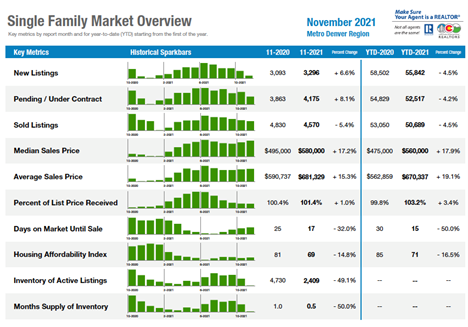
STATEWIDE SINGLE-FAMILY SNAPSHOT
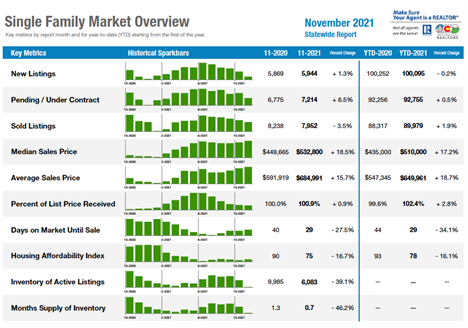
SEVEN-COUNTY DENVER METRO AREA

COLORADO

HOUSING AFFORDABILITY — SEVEN-COUNTY DENVER METRO AREA
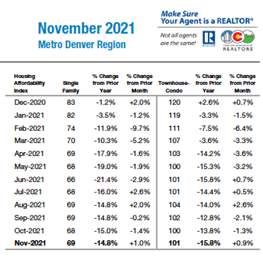
HOUSING AFFORDABILITY – STATEWIDE
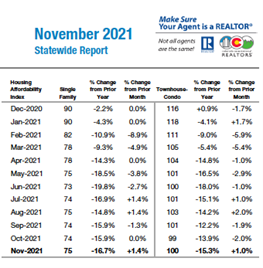
The Colorado Association of REALTORS® Monthly Market Statistical Reports are prepared by Showing Time, a leading showing software and market stats service provider to the residential real estate industry and are based upon data provided by Multiple Listing Services (MLS) in Colorado. The November 2021 reports represent all MLS-listed residential real estate transactions in the state. The metrics do not include “For Sale by Owner” transactions or all new construction. CAR’s Housing Affordability Index, a measure of how affordable a region’s housing is to its consumers, is based on interest rates, median sales prices and median income by county.
The complete reports cited in this press release, as well as county reports are available online at: https://coloradorealtors.com/market-trends/
###
CAR/SHOWING TIME RESEARCH METHODOLOGY
The Colorado Association of REALTORS® (CAR) Monthly Market Statistical Reports are prepared by Showing Time, a Minneapolis-based real estate technology company, and are based on data provided by Multiple Listing Services (MLS) in Colorado. These reports represent all MLS-listed residential real estate transactions in the state. The metrics do not include “For Sale by Owner” transactions or all new construction. Showing Time uses its extensive resources and experience to scrub and validate the data before producing these reports.
The benefits of using MLS data (rather than Assessor Data or other sources) are:
Accuracy and Timeliness – MLS data are managed and monitored carefully.
Richness – MLS data can be segmented
Comprehensiveness – No sampling is involved; all transactions are included.
Oversight and Governance – MLS providers are accountable for the integrity of their systems.
Trends and changes are reliable due to the large number of records used in each report.
Late entries and status changes are accounted for as the historic record is updated each quarter.
The Colorado Association of REALTORS® is the state’s largest real estate trade association representing more than 30,000 members statewide. The association supports private property rights, equal housing opportunities and is the “Voice of Real Estate” in Colorado. For more information, visit https://coloradorealtors.com.


